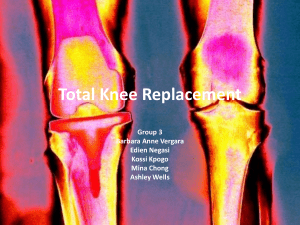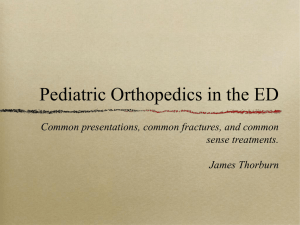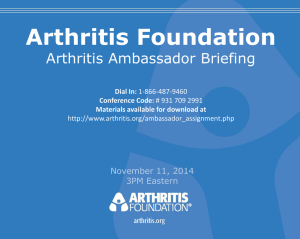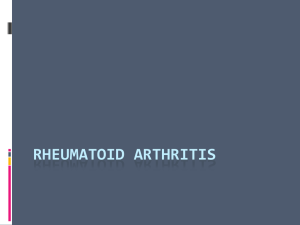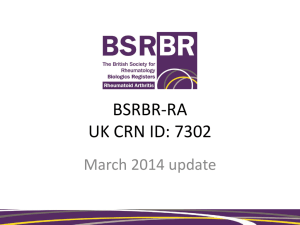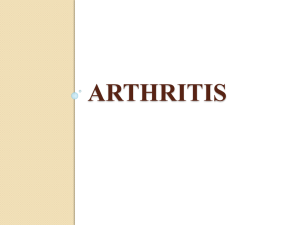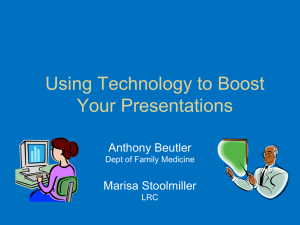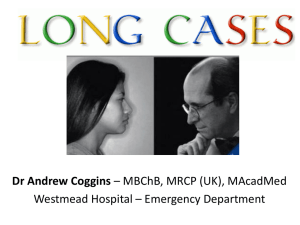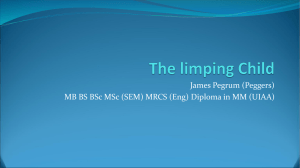Clinical Approach to Acute Arthritis
advertisement
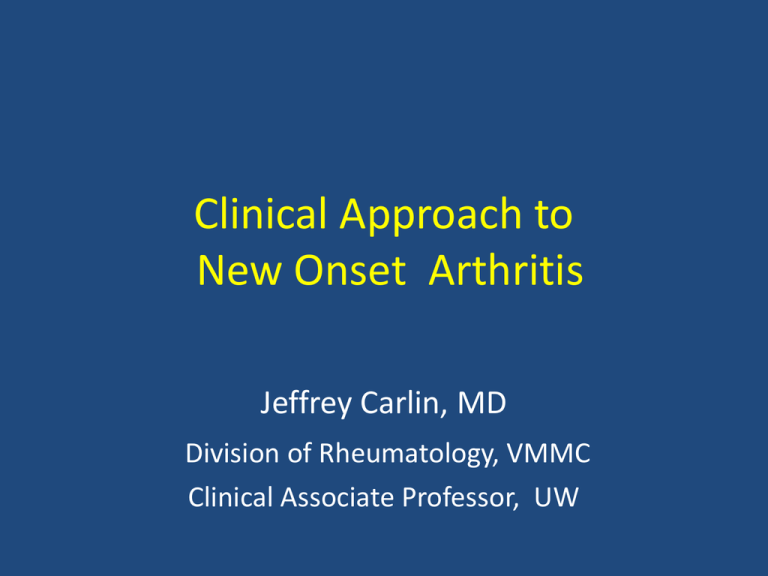
Clinical Approach to New Onset Arthritis Jeffrey Carlin, MD Division of Rheumatology, VMMC Clinical Associate Professor, UW Nothing to declare Acute Arthritis • The sudden onset of inflammation of the joint, causing severe pain, swelling, and redness. • Structural changes in the joint itself may result from persistence of this condition. Key Points 1. Distinguish arthritis from soft tissue non- articular syndromes (discrepancy between “active” and “passive” ROM suggests periarticular/soft tissue) 2. If the problem is articular distinguish single joint from multiple joint involvement 3. Inflammatory or non-inflammatory disease 4. Always consider septic arthritis! Inflammatory Vs. Noninflammatory Feature Inflammatory Noninflammatory Pain (when?) Swelling Erythema Warmth AM stiffness Systemic features î ESR, CRP Synovial fluid WBC Examples Yes (AM) Soft tissue Sometimes Sometimes Prominent Sometimes Frequent WBC >2000 Septic, RA, SLE, Gout Yes (PM) Bony Absent Absent Minor (< 30 ‘) Absent Uncommon WBC < 2000 OA, AVN Acute Monoarthritis • Inflammation (swelling, tenderness, warmth) in one joint • Occasionally polyarticular diseases can present with monoarticular onset: (RA, JRA,Reactive and enteropathic arthritis, Sarcoid arthritis, Viral arthritis, Psoriatic arthritis) Acute Monoarthritis - Etiology • THE MOST CRITICAL DIAGNOSIS TO CONSIDER: INFECTION ! Acute Monoarthritis - Etiology • • • • Septic Crystal deposition (gout, pseudogout) Traumatic (fracture, internal derangement) Other (hemarthrosis, osteonecrosis, presentation of polyarticular disorders) Questions to Ask – History Helps in Differential Diagnosis • Pain come suddenly, minutes? – fracture. • 0ver several hours or 1-2 days? –infectious, crystals, inflammatory arthropathy. • History of IV drug abuse or a recent infection? – septic joint. • Previous similar attacks? – crystals or inflammatory arthritis. • Prolonged courses of steroids? – infection or osteonecrosis of the bone. Acute Monoarthritis Indications for Arthrocentesis – SYNOVIAL FLUID ANALYSIS: The single most useful diagnostic study in initial evaluation of monoarthritis – 1. Suspicion of infection – 2. Suspicion of crystal-induced arthritis – 3. Suspicion of hemarthrosis – 4. Differentiating inflammatory from noninflammatory arthritis Tests to Perform on Synovial Fluid • Gram stain and cultures • Total leukocyte count/differential – Inflammatory vs. non-inflammatory • Polarized microscopy to look for crystals • Not necessary routinely: – Chemistry (glucose, total protein, LDH) unlikely to yield helpful information beyond the previous tests. Synovial Fluid Analysis Joint Fluid Appearance Cell Count Normal Clear/Yellow <200 WBC’s NonInflammatory Clear/Yellow <2000 WBC’s Inflammatory Turbid/Yellow <50,000 WBC’s Septic Pus >50,000 WBC’s Other Tests Indicated for Acute Arthritis 1. Almost always indicated: Radiographs CBC ESR/CRP 2. Indicated in certain patients: Cultures 3. Rarely indicated: Serologic: ANA, RF, HLA-B27 Serum Uric acid level Tests of Acute Phase Reactants • Erythrocyte Sedimentation Test • C-Reactive Protein Patterns of Response of Acute Phase Reactants Gabay C, Kushner I, NEJM , 1999;340:450 ESR’s • Non-specific marker- elevated in rheumatic diseases, infection, malignancy • Can be artificially elevated by: • Pregnancy • Anemia • Nephrotic Syndrome • Benign/Malignant Monoclonal Gammopathies • Age • Obesity • Can be normal in some inflammatory conditions Formula for Age- Related Normals • Men: ESR(mm/hr)= (age in years)/2 • Females ESR (mm/hr)= (age in years + 10)/2 C- Reactive Protein • Produced in liver in response to IL-1 & IL-6 • Rapid rise in response to inflammatory stimuli • Can be affected by: – Obesity/Metabolic Syndrome – Age Formula for Age-Related Normals • Men CRP = (age/65) +.1 mg/dl • Women CRP = (age/65) + .7 mg/dl Septic Joint • • • • • • • Most articular infections – a single joint 15-20% cases polyarticular Most common sites: knee, hip, shoulder 20% patients afebrile Joint pain is moderate to severe Joints visibly swollen, warm, often red Comorbidities: RA, DM, SLE, cancer,etc Septic Joint - Nongonococcal • 80-90% monoarticular • Most develop from hematogenous spread • Most common: – Gram positive aerobes (80%) – Majority with Staph aureus (60%) – Gram negative 18% Likely Causes of Septic Arthritis Gram Stain Pt Characteristic Organism of Concern No Bacteria Young, healthy GC, Staph No Bacteria Hx of RA Staph No bacteria Immunosupression, IV drugs, Hx gm- infection Staph, Strep, Pseudomonas, fungal No Bacteria or Gm - Recent cat/dog bite Pasteurella multocida Gm+ None Staph/Strep Gm- diplococci None GC ( consider meningococcemia) Gm - None Rx for possible pseudomonas Gm - SLE or Sickle Cell Include coverage for Salmonella & Psudomonas No bacteria Hx prosthetic joint Staph epidermidis, Staph aureus No bacteria HX fresh/salt H20 exposure + injury; chronic swelling Mycobacterium marinum Initial Empirical Antibiotic Rx Gram Stain Drug of Choice Alternative Drug Gm + Cocci (small) in pairs & chains Vancomycin 1 gm IV 12 h Cefotaxime 2.0 gm Iv q6-8h Gm+ Cocci (large) singly or in large groups Vancomycin 1 gm IV q12 h Nafcillen 2.0gm Iv q 4h Gm - Bacilli Ceftriaxone 2.0 gm q 24h Imipenem .5 gm IV q 6h Gm- Bacilli Cefotaxime 2.0 gm IV q 6h Imipenem .5 gm IV q 6h None- (Healthy young ptAssume GC but include Gm + coverage Ceftriaxone 2.0 gm q 24h Imipenem .5 gm IV q 6h None- (Underlying disease or Immunosupression Vancomycin 1 gm IV 12 h + Cipro 400mg q 12 h Imipenem .5 gm IV q 6h Acute Gouty Arthritis Gout • • • • • • Caused by monosodium urate crystals Most common type of inflammatory monoarthritis Typically: first MTP joint, ankle, midfoot, knee Pain very severe; cannot stand bed sheet May be with fever and mimic infection The cutaneous erythema may extend beyond the joint and resemble bacterial cellulitis Urate Crystals • Needle-shaped • Strongly negative birefringent Gouty Arthritis Pseudogout Pseudogout • Can cause monoarthritis clinically indistinguishable from gout. • Often precipitated by illness or surgery. • Pseudogout is most common in the knee (50%) and wrist. • Reported in any joint (Including MTP). • CPPD disease may be asymptomatic (deposition of CPP in cartilage). CPPD Crystals • Rod or rhomboidshaped • Weakly positive birefringent Algorithm for w/u of Monoarticular Arthritis Polyarthritis • Definite inflammation (swelling, tenderness, warmth of > 5 joints • A patient with 2-4 joints is said to have pauci- or oligoarticular arthritis Acute Polyarthritis Infection • • • • • • Gonococcal Meningococcal Lyme disease Rheumatic fever Bacterial endocarditis Viral (rubella, parvovirus, Hep. B) Acute Polyarthritis Infection Inflammatory • • • • • • • • • • • • • Gonococcal Meningococcal Lyme disease Rheumatic fever Bacterial endocarditis Viral (rubella, parvovirus, Hep. B) RA JRA SLE Reactive arthritis Psoriatic arthritis Polyarticular gout Sarcoid arthritis Inflammatory Vs. Noninflammatory Feature Inflammatory Mechanical Morning stiffness Fatigue Activity Rest Systemic Corticosteroid >1 h < 30 min Profound Improves Worsens Yes Yes Minimal Worsens Improves No No Temporal Patterns in Polyarthritis • Migratory pattern: – Rheumatic fever, gonococcal (disseminated gonococcemia), early phase of Lyme disease • Additive pattern – RA, SLE, psoriasis • Intermittent: – Gout, reactive arthritis Patterns of Joint Involvement • Symmetric polyarthritis involving small and large joints: viral, RA, SLE, one type of psoriatic (the RAlike). • Asymmetric, oligo- and polyarthritis involving mainly large joints, preferably lower extremities, especially knee and ankle : reactive arthritis, one type of psoriatic, enteropathic arthritis. • DIP joints: Psoriatic. Acute Polyarthritis - RA Rheumatoid Arthritis • Symmetric, inflammatory polyarthritis, involving large and small joints • Acute, severe onset 10-15 %; subacute 20% • Hand characteristically involved • Acute hand deformity: fusiform swelling of fingers due to synovitis of PIPs • RF/Anti-CCP Ab may be negative at onset and may remain negative in 15-20%! • RA is a clinical diagnosis, no laboratory test is diagnostic, just supportive! Rheumatoid Factors Rheumatoid Factors • Autoantibodies to the Fc portion of IgG. • Support a diagnosis of Rheumatoid Arthritis but are not by themselves diagnostic. • Are seen in about 75% to 80% of patients with RA. • Are associated with a poor prognosis in patients with RA. • Are seen in conditions other than RA Rheumatic Diseases with Positive RF • • • • • RA JRA SLE Sjogren’s Scleroderma 80% 20% 20% 90% 20-30% Non-Rheumatic Diseases with Positive RF • • • • • • Hepatitis C Mixed cryoglobulinemia Sarcoidosis Pulmonary Fibrosis Infections Aging < 70% 90% 5-30% 20% varies 5% RF: Clinical Significance • Highly predictive of RA in patients with identified rheumatic disease • May be absent at the onset of disease in up to half of patients with typical clinical picture of RA – approx 20% remain seronegative – many convert within 2 years • Best used to confirm RA for typical presentation – inflammatory polyarthritis, “gel phenomenon,” etc. • Not useful to follow course of illness – generally not helpful to repeat after diagnosis RF: Test Statistics • Sensitivity 80% • Specificity 95% • PPV (unselected populations)- 20-30% (RA population)- 80% • NPV- 95% Anti-Citrulline Antibody Assay ELISA detects antibodies to cyclic citrullinated protein (anti-CCP) Anti-CCP Antibody Assay • Accuracy (Anti-CCP-2 Assay) – Specificity 79% Sensitivity 96-98% • Diagnosis more accurate when combined with RF+ • Present in 50-60% early RA patients • Can be seen 1.5 -9 yrs pre-diagnosis of RA • Predictive for progressive joint damage – Present in up to 40% percentage of RF- patients with erosions – RF+, anti-CCP+ pts have very aggressive disease Viral Arthritis • • • • • • Younger patients Usually presents with prodrome, rash History of sick contact Polyarthritis similar to acute RA Prognosis good; self-limited Examples: Parvovirus B-19, Rubella, Hepatitis B and C, Acute HIV infection, Epstein-Barr virus, mumps Parvovirus B-19 • The virus of “fifth disease”, erythema infectiosum (EI). • Children “slapped cheek”; adults flu-like illness, maculopapular rash on extremities. • Joints involved more in adults (20% of cases). • Frequently RF + • Abrupt onset symmetric polyarthralgia/polyarthritis with stiffness in young women exposed to kids with E.I. • May persist for a few weeks to months. Reactive arthritis Ankylosing spondylitis Psoriatic arthritis Spondyloarthropathy Arthritis associated with inflammatory bowel disease Undifferentiated spondyloarthropathy Inflammatory Back Pain • Onset of back discomfort before age 40 • Insidious onset • > 3 mths duration • Morning stiffness in the back • Improvement with exercise If 4 of these are met, AS is diagnosed Techniques for Imaging SIJ X-ray Radionuclide imaging CT MRI Benefits Shortcomings Quick & cheap Changes occur late May indicate early changes Controversial Clear imaging of early changes, may clarify dx when x-ray borderline Radiation dose Very early disease may still not be detectable May show inflammation & very early changes Price & availability Asymmetric, Inflammatory Oligoarthritis Enthesitis in Spondyloarthropathies Reactive Arthritis • Triggered by specific gut or genito-urinary tract infections – Salmonella, Yersinia, Campylobacter, Shigella – Chlamydia • Joint symptoms appear 1-3 week later – Oligoarthritis; usually lower extremity – Enthesitis • Frequent association with extra-articular findings • A proportion evolve into chronic spondyloarthropathy Extra-articular Features of Reactive Arthritis • • • • • Don’t be put off if they are not present Ask about GI disturbance - even mild Ask about conjunctivitis Take a sexual history (with explanation) Examine eyes and skin (soles/external genitalia) • Look for enthesitis Psoriatic Arthritis Psoriatic Arthritis • Prevalence of arthritis in Psoriasis 10-20% – Psoriasis usually precedes PSA- 75% – 10-15% arthritis precedes Psoriasis – Nail changes common • Psoriatic plaques – Scalp, extensor surfaces, natal cleft, umbilicus Psoriatic Arthritis • Subtypes: – Asymmetric, oligoarticular- associated dactylitis – Predominant DIP involvement – nail changes – Polyarthritis “RA-like” – lacks RF or nodules – Arthritis mutilans – destructive erosive hands/feet – Axial involvement –spondylitis – HIV-associated – more severe Dactylitis “Sausage Toes” – Psoriasis Nail Changes in Psoriatic Arthritis Nail Pitting - Psoriasis European Criteria for Spndyloarthropathy • Inflammatory spine pain or synovitis • And one or more of the following: • Alternating buttocks pain • Sacroiliitis • Enthesopathy • Positive family history • Psoriasis • IBD • Recent episode of urethritis/cervicitis or gastroenteritis HLA-B27 in the General Population • • • • • • Caucasian African-Americans African Blacks Japanese Koreans Native Americans (Haida, Navajo, Eskimos) 6-8% 4% 0% 1% 3-4% 40-50% HLA- B27 and Disease (Caucasians) Disease Association Ankylosing spondylitis 90% Reactive arthritis 60-80% Inflammatory bowel disease 35-75% Psoriatic arthritis With spondylitis 50% With peripheral arthritis 15% Undifferentiated Spondyloarthropathy 70% Anterior Uveitis 50% Sarcoid Acute Sarcoid Arthritis • Löfgren’s syndrome: acute arthritis, erythema nodosum, bilateral hilar adenopathy • Chronic arthritis- (15-20%) – Symmetrical: wrists, pip’s, ankles, knees • Chronic inflammatory disorder – noncaseating granulomas at involved sites • Common with hilar adenopathy 1. Wolfe F, et al Arthritis Care and Research 2010;62; 600-610 2. Wolfe, F et al, Arth & Rheum 1990; 33:160-172 Prognosis of Early Undifferentiated Arthritis • Remission- 13-60% • RA or other Dx- 7-65% • Persistant Disease w/o DX- 10-40% • Monoarticular Arthritis – Remission- 60% – Oligoarticular- 10-40% – Undifferentiated-70% Thank you! Arthritis Of SLE • Musculoskeletal manifestation 90%. • Most have arthralgia. • May have acute inflammatory synovitis RAlike. • Do not develop erosions. • Other clinical features help with DD: malar rash, photosensitivity, rashes, alopecia, oral ulceration. Butterfly Rash – SLE Photosensitivity Alopecia - SLE Arthritis of Rheumatic Fever • Etiology: Streptococcus pyogenes (group A); there is damaging immune response to antecedent infection – molecular cross reaction with target organs “molecular mimicry”. • Onset approximately 3wks after exposure • Migratory polyarthritis, large joints: knees, ankles, elbows, wrists. • Major manifestations: carditis, polyarthritis, chorea, erythema marginatum, subcutaneous nodules. Erythema Marginatum – Rheumatic Fever • Circinate • Evanenscent • Nonpruritic rash Rheumatic Fever – Subcutaneous Nodes Post-Strep Reactive Arthritis • Onset 7-10 days after Strep A • Oligoarthritis lasting >3weeks • Evidence for recent infection: Throat culture, +ASO titers Adult Still’s Disease and JRA Rash • Salmon or pale-pink • Blanching • Macules or maculopapules • Transient (minutes or hours) • Most common on trunk • Fever related Disseminated Gonococcemia – Pustules Septic Joint - Gonococcal • Most common cause of septic arthritis • Often preceded by disseminated gonococcemia • Sexually active individual, 5-7 days h/o fever, chills, skin lesions, migratory arthralgias and tenosynovitis persistent monoarthritis • Women often menstruating or pregnant • Genitourinary disease often asymptomatic Viral Arthritides - Parvovirus Rubella Arthritis • German measles. • Young women exposed to school-aged children. • Arthritis in 1/3 of natural infections; also following vaccination. • Morbilliform rash, constitutional symptoms. • Symmetric inflammatory arthritis (small and large joints). 1987 ACR Criteria for Rheumatoid Arthritis • 4/7 Criteria – AM Stiffness lasting > 1 hr – Swelling in >3 joint areas simultaneously – Swelling in Wrist, MCP or PIP joint – Symmetrical Arthritis – Rheumatoid Nodules – Positive RF (or Anti-CCP AB) – XRay Changes Keratoderma Blenorrhagicum Circinate Balanitis – Reactive Arthritis Reactive Arthritis - Conjunctivitis Reactive Arthritis – Palate Erosions Recent Prevalence Studies of AS and Related Diseases (Khan, MA, Annals of Internal Medicine.2002;136:896-907) Ethnic Group or Region Eskimos Eskimos (Alaska & Siberia) + Chukchi Sami Northern Norway Mordovia Western Europe Germany (Berlin) Frequency of HLA-B27 in Population Prevalence of AS in Adults Prevalence of All Spondyloarthropathies in Adults General Population General Population HLA-B27 Positive Persons 40 25-50 0.4 24 10-16 1.8 1.4 16 8 0.5 0.2 2 9 0.9 6.4 1.6 HLA-B27 Positive Persons 2.5 2-3.4 4.2 1.9 13.6 6.8 Lyme Disease Lyme Arthritis • Erythema migrans 7-10 days after Borrelia burgdorferi tick bite • Early dissemination– Migratory arthralgias, fever, systemic complaints • Late dissemination/Chronic disease– Migratory oligoarthritis – Carditis – Neurological
